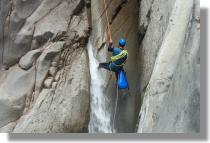|
|
WHAT IS CANYONING (OR
CANYONEERING)?
Canyoning is an
outdoor adventure sport involved with the descent of
steep and narrow canyons that have been carved by rivers
and flash floods. Canyoning, or Canyoneering as it
is known in the US, often includes working one's way down
active waterfalls and cascades. It is a relatively recent
sport, the
first canyons on Reunion having been equipped with
rappel stations some ten years ago. More than 100 canyons
on the island have been descended, spanning a range from
the easy, accessible by beginners, to the most
difficult, reserved for those with much technical
training and experience. |
|

|
|
The descents
of these canyons often consist of a series of
rappels down the cascades, using rope techniques for
borrowed from rock climbers. There are also
the thrills of natural toboggans (or water
slides),
jumps, and swims across small lakes.
| |
Who
can carry out this activity?
|

|
There are many types of
canyon on Reunion Island, and accordingly one finds
many levels of participants in this sport. There
are several "canyons of initiation" that are
feasible for a great number of people, including
complete beginners. It is enough
to be in good physical condition, not to be afraid of water
or heights,
and to know how to swim. Under supervision of a guide,
the necessary techniques can be learned on the
spot. For more serious explorations, longer routes
with more technical challenges, often in wild places
far from any civilization, can be carried out.
Such expeditions can take several days. |
What are
the essential tools of the sport?
|
This sport requires
each individual to have a helmet, a climbing harness,
rappel devices, a wet-suit (although the
water of the canyons on Reunion is not particularly cold,
some thermal
protection is essential when spending several hours in
water), and proper foot gear. In addition, each
group should carry static
ropes sufficient for the height of
the cascades, watertight packs, emergency
equipment, etc...
|

|
Canyoning in Reunion
Island:
|

|
|
This activity
may be practiced
either in an autonomous way by canyoneers who know the
requisite techniques of the sport, or under the
direction of a licensed guide who will provide
instruction that will permit a safe descent of the
canyon.
| |
The weather plays a
dominant role when choosing which canyons to be
carried out, and when to go. The microclimates can feature strong
localized precipitation and a safe descent usually requires good
weather. One finds the more watery canyons in the East and in
Salazie, and somewhat drier canyons in Cilaos, Mafate,
and on the West Coast. The nature of the
rock, which is often very abrasive, must be taken into account
when assessing the useful life of climbing ropes here.
With its abundance of superb canyons, Reunion Island is a
mecca for canyoning, a most beautiful "spot" that attracts impassioned
enthusiasts from around the
world. |
Most beautiful Canyons:
|
Among the "Top" canyons:
- as initiation : Bassins de
St-Gilles, Fleurs Jaunes Cilaos, Ferrière Cilaos, Bras
Rouge Cilaos, Trou Blanc Salazie, Voile de la Mariée
Salazie, Bras Noir inférieur
- more difficult
: Takamaka1, Bras Piton, Dudu, Ravine Grand-Mère
Mafate, Canyons de Langevin, le Trou de Fer (Iron
Hole) |

|
For
some more description in English...:
A Web site :
CRYSTALCANYONS, discusses trips made to Reunion Island in June and October
2002. It describes adventures, along with some practical
information for visiting. It has a good trip report
about descending the Trou de
Fer
(Iron Hole), a mythic canyon in Reunion
Island.
To practice this activity with commercial guides
...:
Go to the "professionnal page" of this
website, where there are links to professional guide services
at RicaRic, Reunion
Sensations, Austral Aventures, etc... |
